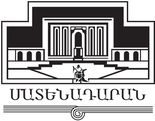On June 15-17, 2017 at the Sorbonne University in Paris an international conference “The Physiologus Between East and West: Distribution and Transmission of an Early Christian Text on Nature” took place.
This early Christian writing in Greek, probably composed in the late 2nd century in Alexandria, describes the nature and behavior of various real and imaginary animals, as well as plants and stones (which explains the title «Բարոյախոս» [Moralist] of the Armenian version), followed by their interpretation as allegory of human beings, Christ, the Church, and the devil. This collection translated from Greek into Latin (twice), Ethiopian, Armenian (from Armenian into Georgian), Syriac, Coptic, Arabic, Old Slavonic (and from it into Old Russian), was widely spread throughout the Christian world. Western Bestiaries derive from the Latin version, but they were not discussed in the conference.
Senior researchers of Matenadaran Gohar Muradyan and Aram Topchyan participated in the conference. Gohar Muradyan presented “The Armenian Version of the Physiologus and its later Recensions” (an excerpt from the author’s critical edition of the translation proper and the latest and shortest recension; see G. Muradyan, Physiologus, the Greek and Armenian Versions with a Study of Transla¬tion Technique (Hebrew University Armenian Studies 6, series editor M.E. Stone), Leuven – Paris – Dudley, MA: Peeters, 2005. For the second edition see “Banber Matenadaran”, 23, 2016, pp. 291-329). Aram Topchyan spoke about the “Traces of the Physiologus in Later Armenian Literature.” The Armenian recensions are preserved in over 40 manuscripts.
It is noteworthy that the Coptic Physiologus is not actually extant, but the citations in various works allow suggesting that a complete translation has existed. The origin of the Arabic version is not clear; it could have been translated from Coptic or Syriac. And the Georgian version, translated from Armenian, has been preserved in one manuscript; according to Jost Gippert, the translator was not too proficient in Georgian and probably was an Armenian. Another noteworthy revelation is the fact that the only manuscript written in the X century Shatberdi (Kłarjkʽ) is a miscellany, and almost all of its materials, in Gippert’s opinion, are translated from Armenian.
The rich and complicated manuscript tradition of the Greek text was presented by Caroline Macé who pointed out the importance of the Armenian translation (and the existence of its critical edition) for preparing a new Greek critical text (Francesco Sbordone’s critical edition published in 1936, in which, on the basis of 77 manuscripts, 4 recensions and various sub-recensions are singled out, needs to be revised, especially in the light of the fact that there are more than 20 newly discovered manuscripts, presented during the conference).
Some papers were devoted to the unique iconography of illuminated Greek and Latin manuscripts of the Physiologus. It is noteworthy that the Armenian and other “Eastern” versions have not been illustrated. However, in the Armenian manuscripts one can encounter images of creatures described in the Physiologus, in the form of marginal decorations (sirens and a lion), on title-pages of the Gospels (sirens), and a pelican feeding his young with its blood as an allegory of Christ. Aram Topchyan demonstrated several images during his presentation.
A collection of the papers of the conference will be published.
For the conference program, see here.
